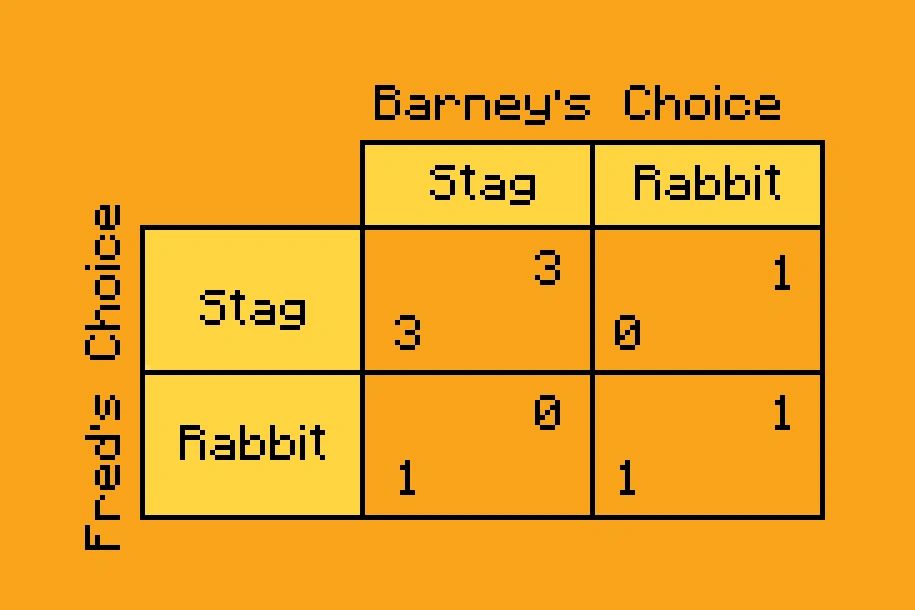At the heart of “The Stag Hunt” is the question of trust. In order to achieve maximum payoff, players must coordinate and trust one another to take the agreed to strategy. However, with a risk-free and independent strategy available, coordination may fail – perhaps, after all, one of the players/hunters does give in to hunger or impatience, satisfying his own needs at the expense of the greater good. With that, today, let’s explore a game theoretic modeling of “The Stag Hunt”.
“The Stag Hunt” Modeled As A Simultaneous-Move Coordination Game
Fred and Barney are Stone Age rabbit hunters. One evening, while carousing, they happen to engage in some shop talk. As they exchange information and ideas, they realize that by cooperating they could hunt much bigger game, such as stag. One person on his own cannot expect any success hunting stag. But done jointly, each day’s stag hunting is expected to yield six times as much meat as a day’s rabbit hunting by one person. Cooperation promises great advantage: each hunter’s share of meat from a big-game hunt is three times what he can get hunting rabbits on his own.
The two agree to go big-game hunting together the following day and return to their respective caves. Unfortunately, they caroused too well, and both have forgotten whether they agreed to go after stag, or intended to go their own ways and hunt rabbit. The hunting grounds for the two species are in opposite directions. There were no cell phones in those days, and this was before the two became neighbors, so one could not quickly visit the other’s cave to ascertain where to go. Each would have to make the decision the next morning in isolation.
Therefore, the two end up playing a simultaneous-move game of deciding where to go. If we call each hunter’s quantity of meat from a day’s rabbit hunting 1, then the share of each from successful coordination in hunting stag is 3. The payoff table of the game is as such:

The Nash Equilibrium Of “The Stag Hunt” Game
Fred’s thinking goes as follows: “Should I go by myself after rabbits and make sure of my usual, albeit small, quantity of meat? In other words, should I take 1 for sure instead of risking either 3 or nothing? It depends on what I think Barney is likely to do, so let me put myself in his shoes and think what he is thinking. Oh, he is wondering what I am likely to do and is trying to put himself in my shoes!”
What’s the solution to the circular thinking of “The Stag Hunt” Game? The solution is Nash’s Equilibrium! As said by Dixit and Nalebuff in The Art of Strategy: “Such an outcome in a game, where the action of each player is best for him given his beliefs about the other’s action, and the action of each is consistent with the other’s belief about it, neatly squares the circle of thinking about thinking.”
A Nash Equilibrium, also called strategic equilibrium, is a list of strategies, one for each player, which has the property that no player can unilaterally (without the agreement of others) change his strategy and get a better payoff. Since players are also rational, it is reasonable that each player expects his opponent to follow the recommendation as well. Nash formally defined equilibrium of a non-cooperative game to be “a configuration of strategies, such that no player acting on his own can change his strategy to achieve a better outcome for himself”. The outcome of such a game must be a Nash equilibrium if it is to conform to the assumption of rational individual behavior.
Let’s examine the Nash Equilibria of “The Stag Hunt” game detailed in the previous section:

The Hunt’s Conundrum
Uh oh! There are two pure-strategy equilibria found in the example above: (Stag,Stag) with payoff 3 for each player and (Rabbit, Rabbit) with payoff 1 for each player. These are Nash Equilibria because neither player can unilaterally change his strategy without ruining his payoff. At one of the Nash Equilibria (Stag,Stag), players choose to cooperate, while at the Nash Equilibrium of (Rabbit,Rabbit), players choose to defect and go their own, independent routes. Fred’s best choice depends on what Barney does, and vice versa. For neither player is there a strategy that is best regardless of what the other does.
So, how do we pick one Equilibria over the other as the solution? Is there a way to predict cooperation towards hunting the big game, or to anticipate the independent route of the rabbit hunters? These are questions to be answered in another article – stay tuned!
Thanks for reading!
